import pandas as pdref
신용카드 거래에 대한 그래프 분석
신용카드 거래 그래프 생성
그래프에서 속성 및 커뮤니티 추출
사기 거래 분류에 지도 및 비지도 머신러닝 알고리즘 적용
import os
import math
import numpy as np
import networkx as nx
import matplotlib.pyplot as plt
%matplotlib inline
default_edge_color = 'gray'
default_node_color = '#407cc9'
enhanced_node_color = '#f5b042'
enhanced_edge_color = '#cc2f04'import pandas as pd
df = pd.read_csv("fraudTrain.csv")
df = df[df["is_fraud"]==0].sample(frac=0.20, random_state=42).append(df[df["is_fraud"] == 1])
df.head()| Unnamed: 0 | trans_date_trans_time | cc_num | merchant | category | amt | first | last | gender | street | ... | lat | long | city_pop | job | dob | trans_num | unix_time | merch_lat | merch_long | is_fraud | |
|---|---|---|---|---|---|---|---|---|---|---|---|---|---|---|---|---|---|---|---|---|---|
| 669418 | 669418 | 2019-10-12 18:21 | 4.089100e+18 | fraud_Haley, Jewess and Bechtelar | shopping_pos | 7.53 | Debra | Stark | F | 686 Linda Rest | ... | 32.3836 | -94.8653 | 24536 | Multimedia programmer | 1983-10-14 | d313353fa30233e5fab5468e852d22fc | 1350066071 | 32.202008 | -94.371865 | 0 |
| 32567 | 32567 | 2019-01-20 13:06 | 4.247920e+12 | fraud_Turner LLC | travel | 3.79 | Judith | Moss | F | 46297 Benjamin Plains Suite 703 | ... | 39.5370 | -83.4550 | 22305 | Television floor manager | 1939-03-09 | 88c65b4e1585934d578511e627fe3589 | 1327064760 | 39.156673 | -82.930503 | 0 |
| 156587 | 156587 | 2019-03-24 18:09 | 4.026220e+12 | fraud_Klein Group | entertainment | 59.07 | Debbie | Payne | F | 204 Ashley Neck Apt. 169 | ... | 41.5224 | -71.9934 | 4720 | Broadcast presenter | 1977-05-18 | 3bd9ede04b5c093143d5e5292940b670 | 1332612553 | 41.657152 | -72.595751 | 0 |
| 1020243 | 1020243 | 2020-02-25 15:12 | 4.957920e+12 | fraud_Monahan-Morar | personal_care | 25.58 | Alan | Parsons | M | 0547 Russell Ford Suite 574 | ... | 39.6171 | -102.4776 | 207 | Network engineer | 1955-12-04 | 19e16ee7a01d229e750359098365e321 | 1361805120 | 39.080346 | -103.213452 | 0 |
| 116272 | 116272 | 2019-03-06 23:19 | 4.178100e+15 | fraud_Kozey-Kuhlman | personal_care | 84.96 | Jill | Flores | F | 639 Cruz Islands | ... | 41.9488 | -86.4913 | 3104 | Horticulturist, commercial | 1981-03-29 | a0c8641ca1f5d6e243ed5a2246e66176 | 1331075954 | 42.502065 | -86.732664 | 0 |
5 rows × 23 columns
df["is_fraud"].value_counts()0 208514
1 6006
Name: is_fraud, dtype: int64- 총 265,342건 거래 중 7,506건(2,83%)가 사기
- 이분 접근 방식 \(G=(V,E,w)\)
\(V=V_C \cup V_m\)
\(c \in V_c\) \(c\):고객
\(m \in V_m\) \(m\):판매자
- 이분그래프
def build_graph_bipartite(df_input, graph_type=nx.Graph()):
df=df_input.copy()
mapping={x:node_id for node_id, x in enumerate(set(df["cc_num"].values.tolist()+\
df["merchant"].values.tolist()))}
df["from"]=df["cc_num"].apply(lambda x:mapping[x]) #엣지의 출발점
df["to"]=df["merchant"].apply(lambda x:mapping[x]) #엣지의 도착점
df = df[['from', 'to', "amt", "is_fraud"]].groupby(['from','to']).agg({"is_fraud":"sum","amt":"sum"}).reset_index()
df["is_fraud"]=df["is_fraud"].apply(lambda x:1 if x>0 else 0)
G=nx.from_edgelist(df[["from","to"]].values, create_using=graph_type)
nx.set_edge_attributes(G, {(int(x["from"]),int(x["to"])):x["is_fraud"] for idx, x in df[["from","to","is_fraud"]].iterrows()}, "label") #엣지 속성 설정,각 속성의 사기 여부부
nx.set_edge_attributes(G,{(int(x["from"]),int(x["to"])):x["amt"] for idx,x in df[["from","to","amt"]].iterrows()}, "weight") # 엣지 속성 설정, 각 엣지의 거래 금액
return G- 판매자, 고객에게 node 할당
G_bu = build_graph_bipartite(df, nx.Graph(name="Bipartite Undirect"))- 무향 그래프 작성
- 삼분그래프
def build_graph_tripartite(df_input, graph_type=nx.Graph()):
df=df_input.copy()
mapping={x:node_id for node_id, x in enumerate(set(df.index.values.tolist() +
df["cc_num"].values.tolist() +
df["merchant"].values.tolist()))}
df["in_node"]= df["cc_num"].apply(lambda x: mapping[x])
df["out_node"]=df["merchant"].apply(lambda x:mapping[x])
G=nx.from_edgelist([(x["in_node"], mapping[idx]) for idx, x in df.iterrows()] +\
[(x["out_node"], mapping[idx]) for idx, x in df.iterrows()], create_using=graph_type)
nx.set_edge_attributes(G,{(x["in_node"], mapping[idx]):x["is_fraud"] for idx, x in df.iterrows()}, "label")
nx.set_edge_attributes(G,{(x["out_node"], mapping[idx]):x["is_fraud"] for idx, x in df.iterrows()}, "label")
nx.set_edge_attributes(G,{(x["in_node"], mapping[idx]):x["amt"] for idx, x in df.iterrows()}, "weight")
nx.set_edge_attributes(G,{(x["out_node"], mapping[idx]):x["amt"] for idx, x in df.iterrows()}, "weight")
return G
- 판매자, 고객, 거래에 노드 할당
G_tu = build_graph_tripartite(df, nx.Graph())from networkx.algorithms import bipartite
all([bipartite.is_bipartite(G) for G in [G_bu, G_tu]])True- 그래프가 실제 이분그래프인지 검증하는 코드
for G in [G_bu, G_tu]:
print(nx.number_of_nodes(G))1636
216156for G in [G_bu, G_tu]:
print(nx.number_of_edges(G))169972
429040네트워크 토폴로지
- 각 그래프별 차수 분포 살펴보기
for G in [G_bu, G_tu]:
plt.figure(figsize=(10,10))
degrees = pd.Series({k:v for k, v in nx.degree(G)})
degrees.plot.hist()
plt.yscale("log")
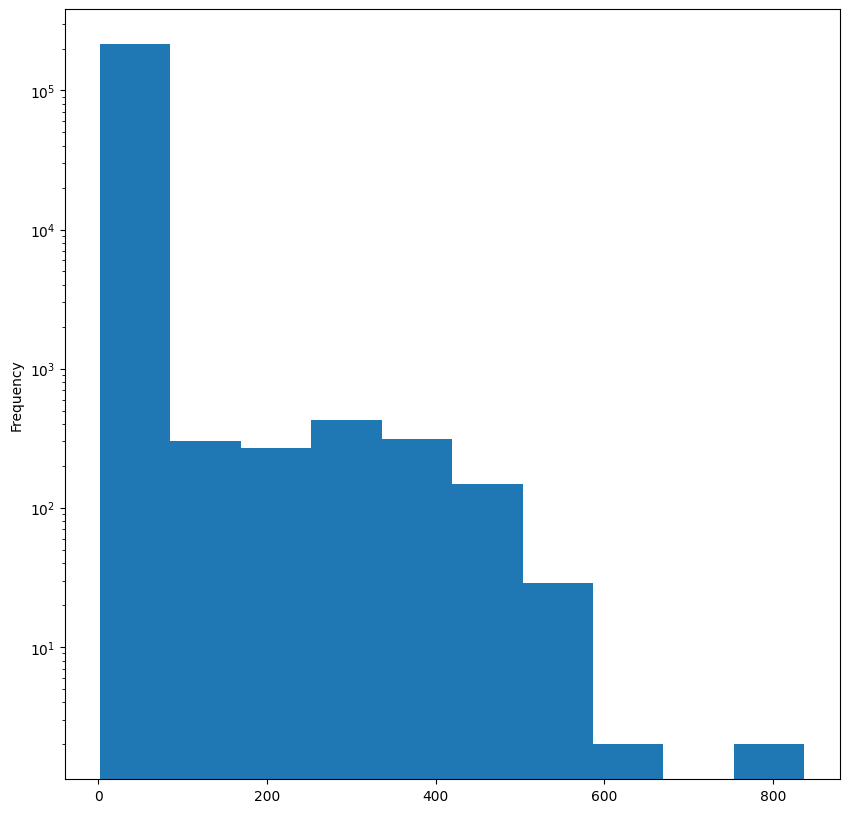
- 각 그래프 간선 가중치 분포
for G in [G_bu, G_tu]:
allEdgeWeights = pd.Series({
(d[0],d[1]):d[2]["weight"]
for d in G.edges(data=True)})
np.quantile(allEdgeWeights.values,
[0.10, 0.50, 0.70, 0.9])
np.quantile(allEdgeWeights.values,[0.10, 0.50, 0.70, 0.9])array([ 4.17, 48.31, 76.29, 146.7 ])- 매게 중심성 측정 지표
for G in [G_bu, G_tu]:
plt.figure(figsize=(10,10))
bc_distr = pd.Series(nx.betweenness_centrality(G))
bc_distr.plot.hist()
plt.yscale("log")KeyboardInterrupt: 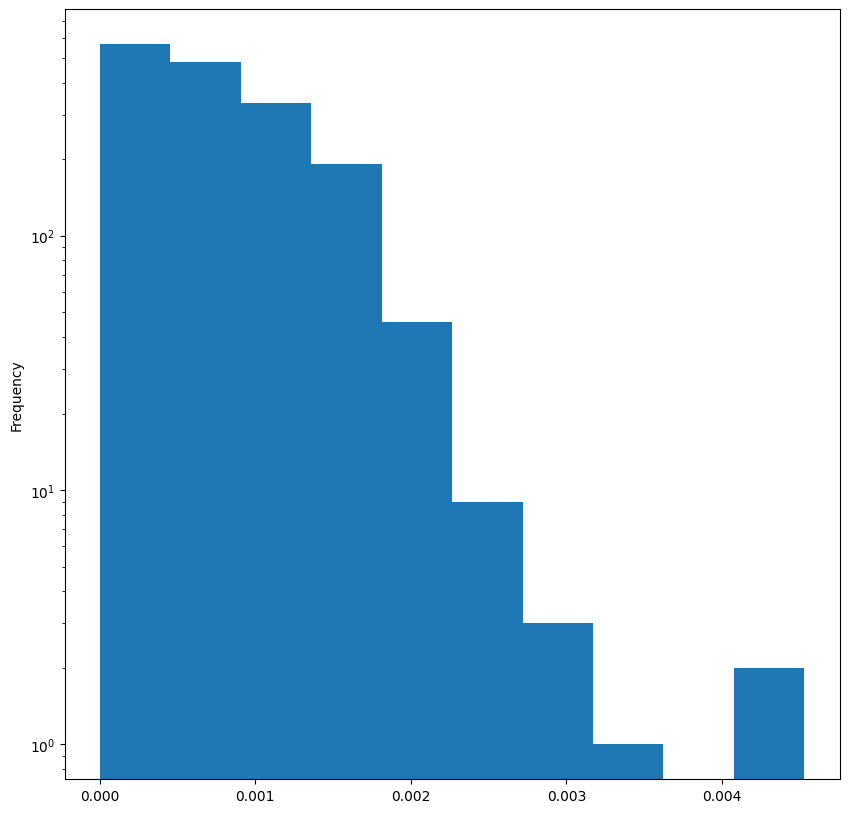
<Figure size 1000x1000 with 0 Axes>그래프 내에서 노드가 얼마나 중심적인 역할을 하는지 나타내는 지표
해당 노드가 얼마나 많은 최단경로에 포함되는지 살피기
노드가 많은 최단경로를 포함하면 해당노드의 매개중심성은 커진다.
- 상관계수
for G in [G_bu, G_tu]:
print(nx.degree_pearson_correlation_coefficient(G))-0.10159189882353903
-0.8017506210033467커뮤니티 감지
# pip install python-louvainimport networkx as nx
import communityimport community
for G in [G_bu, G_tu]:
parts = community.best_partition(G, random_state=42, weight='weight')communities = pd.Series(parts)print(communities.value_counts().sort_values(ascending=False))12 4019
71 3999
27 3743
52 3739
43 3679
...
32 1110
93 1097
49 1060
26 1003
33 892
Length: 96, dtype: int64커뮤니티 감지를 통해 특정 사기 패턴 식별
커뮤니티 추출 후 포함된 노드 수에 따라 정렬
communities.value_counts().plot.hist(bins=20)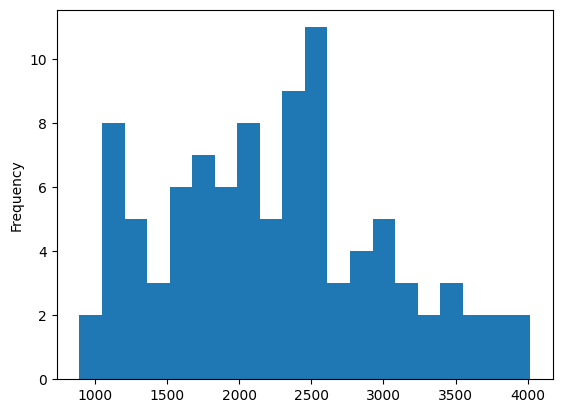
- 2500부근에 형성되었고 ..
graphs = []
d = {}
for x in communities.unique():
tmp = nx.subgraph(G, communities[communities==x].index)
fraud_edges = sum(nx.get_edge_attributes(tmp, "label").values())
ratio = 0 if fraud_edges == 0 else (fraud_edges/tmp.number_of_edges())*100
d[x] = ratio
graphs += [tmp]
pd.Series(d).sort_values(ascending=False)48 8.684864
13 6.956522
55 6.781235
45 6.743257
88 6.338616
...
93 0.996377
75 0.952381
51 0.765957
82 0.737265
33 0.335946
Length: 96, dtype: float64사기 거래 비율 계산. 사기 거래가 집중된 특정 하위 그래프 식별
특정 커뮤니티에 포함된 노드를 사용하여 노드 유도 하위 그래프 생성
하위 그래프: 모든 간선 수에 대한 사기 거래 간선 수의 비율로 사기 거래 백분율 계싼
#pip install scipygId = 48
plt.figure(figsize=(10,10))
spring_pos = nx.spring_layout(graphs[gId])
plt.axis("off")
edge_colors = ["r" if x == 1 else "g" for x in nx.get_edge_attributes(graphs[gId], 'label').values()]
nx.draw_networkx(graphs[gId], pos=spring_pos, node_color=default_node_color,
edge_color=edge_colors, with_labels=False, node_size=15)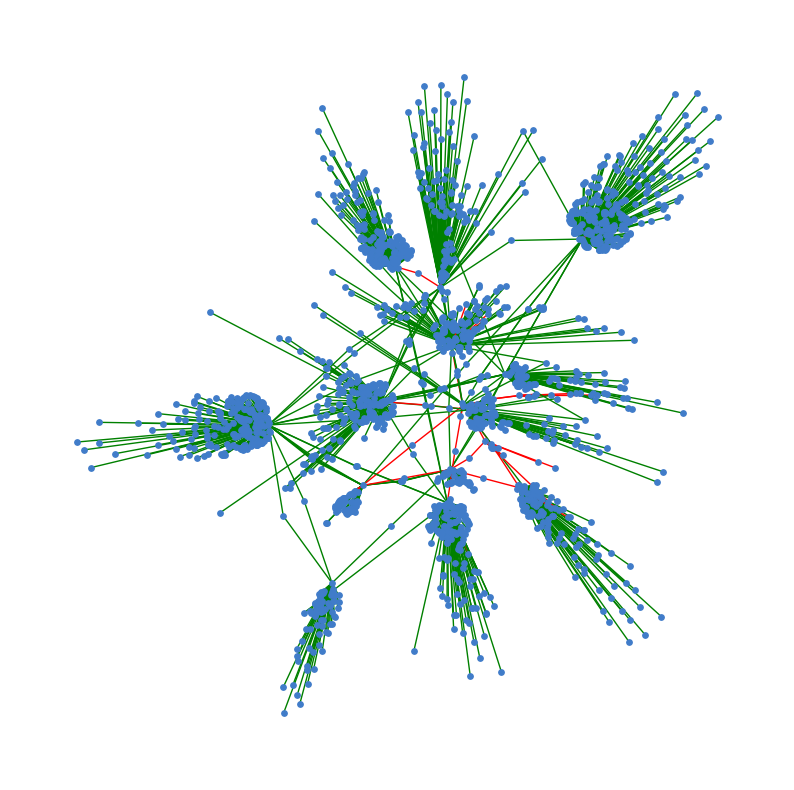
커뮤니티 감지 알고리즘에 의해 감지된 노드 유도 하위 그래프 그리기
특정 커뮤니티 인덱스 gId가 주어지면 해당 커뮤니티에서 사용 가능한 노드로 유도 하위 그래프 추출하고 얻는다.
pd.Series(d).plot.hist(bins=20)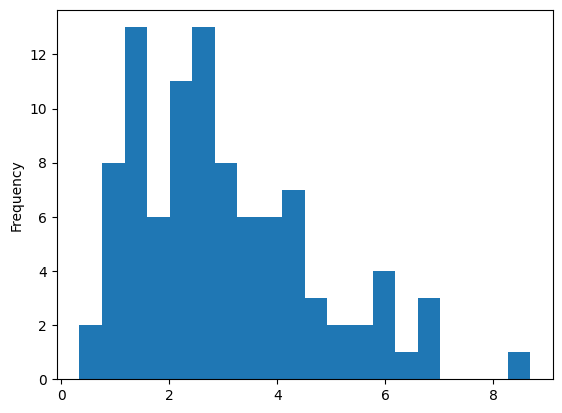
사기 탐지를 위한 지도 및 비지도 임베딩
트랜잭션 간선으로 표기
각 간선을 올바른 클래스(사기 또는 정상)으로 분류
지도학습
토멕링크
- 아래는 랜덤다운
from sklearn.utils import resample
df_majority = df[df.is_fraud==0]
df_minority = df[df.is_fraud==1]
df_maj_dowsampled = resample(df_majority,
n_samples=len(df_minority),
random_state=42)
df_downsampled = pd.concat([df_minority, df_maj_dowsampled])
print(df_downsampled.is_fraud.value_counts())
G_down = build_graph_bipartite(df_downsampled)1 6006
0 6006
Name: is_fraud, dtype: int64무작위 언더샘플링 사용
소수 클래스(사기거래)이 샘플 수 와 일치시키려고 다수 클래스(정상거래)의 하위 샘플을 가져옴
데이터 불균형을 처리하기 위해서
from sklearn.model_selection import train_test_split
train_edges, test_edges, train_labels, test_labels = train_test_split(list(range(len(G_down.edges))),
list(nx.get_edge_attributes(G_down, "label").values()),
test_size=0.20,
random_state=42)edgs = list(G_down.edges)
train_graph = G_down.edge_subgraph([edgs[x] for x in train_edges]).copy()
train_graph.add_nodes_from(list(set(G_down.nodes) - set(train_graph.nodes)))- 데이터 8:2 비율로 학습 검증
pip install node2vecCollecting node2vec
Downloading node2vec-0.4.6-py3-none-any.whl (7.0 kB)
Requirement already satisfied: joblib<2.0.0,>=1.1.0 in /home/coco/anaconda3/envs/py38/lib/python3.8/site-packages (from node2vec) (1.2.0)
Collecting gensim<5.0.0,>=4.1.2
Downloading gensim-4.3.1-cp38-cp38-manylinux_2_17_x86_64.manylinux2014_x86_64.whl (26.5 MB)
━━━━━━━━━━━━━━━━━━━━━━━━━━━━━━━━━━━━━━━━ 26.5/26.5 MB 71.8 MB/s eta 0:00:0000:0100:01
Collecting tqdm<5.0.0,>=4.55.1
Downloading tqdm-4.65.0-py3-none-any.whl (77 kB)
━━━━━━━━━━━━━━━━━━━━━━━━━━━━━━━━━━━━━━━━ 77.1/77.1 kB 18.6 MB/s eta 0:00:00
Collecting networkx<3.0,>=2.5
Downloading networkx-2.8.8-py3-none-any.whl (2.0 MB)
━━━━━━━━━━━━━━━━━━━━━━━━━━━━━━━━━━━━━━━━ 2.0/2.0 MB 90.4 MB/s eta 0:00:00
Requirement already satisfied: numpy<2.0.0,>=1.19.5 in /home/coco/anaconda3/envs/py38/lib/python3.8/site-packages (from node2vec) (1.24.2)
Requirement already satisfied: scipy>=1.7.0 in /home/coco/anaconda3/envs/py38/lib/python3.8/site-packages (from gensim<5.0.0,>=4.1.2->node2vec) (1.10.1)
Collecting smart-open>=1.8.1
Downloading smart_open-6.3.0-py3-none-any.whl (56 kB)
━━━━━━━━━━━━━━━━━━━━━━━━━━━━━━━━━━━━━━━━ 56.8/56.8 kB 13.6 MB/s eta 0:00:00
Installing collected packages: tqdm, smart-open, networkx, gensim, node2vec
Attempting uninstall: networkx
Found existing installation: networkx 3.0
Uninstalling networkx-3.0:
Successfully uninstalled networkx-3.0
Successfully installed gensim-4.3.1 networkx-2.8.8 node2vec-0.4.6 smart-open-6.3.0 tqdm-4.65.0
Note: you may need to restart the kernel to use updated packages.from node2vec import Node2Vec
from node2vec.edges import HadamardEmbedder, AverageEmbedder, WeightedL1Embedder, WeightedL2Embedder
node2vec_train = Node2Vec(train_graph, weight_key='weight')
model_train = node2vec_train.fit(window=10)Generating walks (CPU: 1): 100%|██████████| 10/10 [00:04<00:00, 2.44it/s]- Node2Vec 알고리즘 사용해 특징 공간 구축
from sklearn.ensemble import RandomForestClassifier
from sklearn import metrics
classes = [HadamardEmbedder, AverageEmbedder, WeightedL1Embedder, WeightedL2Embedder]
for cl in classes:
embeddings_train = cl(keyed_vectors=model_train.wv)
train_embeddings = [embeddings_train[str(edgs[x][0]), str(edgs[x][1])] for x in train_edges]
test_embeddings = [embeddings_train[str(edgs[x][0]), str(edgs[x][1])] for x in test_edges]
rf = RandomForestClassifier(n_estimators=1000, random_state=42)
rf.fit(train_embeddings, train_labels);
y_pred = rf.predict(test_embeddings)
print(cl)
print('Precision:', metrics.precision_score(test_labels, y_pred))
print('Recall:', metrics.recall_score(test_labels, y_pred))
print('F1-Score:', metrics.f1_score(test_labels, y_pred)) <class 'node2vec.edges.HadamardEmbedder'>
Precision: 0.6953125
Recall: 0.156140350877193
F1-Score: 0.2550143266475645
<class 'node2vec.edges.AverageEmbedder'>
Precision: 0.6813353566009105
Recall: 0.787719298245614
F1-Score: 0.7306753458096015
<class 'node2vec.edges.WeightedL1Embedder'>
Precision: 0.5925925925925926
Recall: 0.028070175438596492
F1-Score: 0.05360134003350084
<class 'node2vec.edges.WeightedL2Embedder'>
Precision: 0.5833333333333334
Recall: 0.02456140350877193
F1-Score: 0.04713804713804714Node2Vec 알고리즘 사용해 각 Edge2Vec 알고리즘으로 특징 공간 생성
sklearn 파이썬 라이브러리의 RandomForestClassifier은 이전 단계에서 생성한 특징에 대해 학습
검증 테스트 위해 정밀도, 재현율, F1-score 성능 지표 측정
비지도학습
k-means 알고리즘 사용
지도학습과의 차이점은 특징 공간이 학습-검증 분할을 안함.
nod2vec_unsup = Node2Vec(G_down, weight_key='weight')
unsup_vals = nod2vec_unsup.fit(window=10)Generating walks (CPU: 1): 100%|██████████| 10/10 [00:04<00:00, 2.25it/s]- 다운샘플링 절차에 전체 그래프 알고리즘 계산
from sklearn.cluster import KMeans
classes = [HadamardEmbedder, AverageEmbedder, WeightedL1Embedder, WeightedL2Embedder]
true_labels = [x for x in nx.get_edge_attributes(G_down, "label").values()]
for cl in classes:
embedding_edge = cl(keyed_vectors=unsup_vals.wv)
embedding = [embedding_edge[str(x[0]), str(x[1])] for x in G_down.edges()]
kmeans = KMeans(2, random_state=42).fit(embedding)
nmi = metrics.adjusted_mutual_info_score(true_labels, kmeans.labels_)
ho = metrics.homogeneity_score(true_labels, kmeans.labels_)
co = metrics.completeness_score(true_labels, kmeans.labels_)
vmeasure = metrics.v_measure_score(true_labels, kmeans.labels_)
print(cl)
print('NMI:', nmi)
print('Homogeneity:', ho)
print('Completeness:', co)
print('V-Measure:', vmeasure)/home/coco/anaconda3/envs/py38/lib/python3.8/site-packages/sklearn/cluster/_kmeans.py:870: FutureWarning: The default value of `n_init` will change from 10 to 'auto' in 1.4. Set the value of `n_init` explicitly to suppress the warning
warnings.warn(
/home/coco/anaconda3/envs/py38/lib/python3.8/site-packages/sklearn/cluster/_kmeans.py:870: FutureWarning: The default value of `n_init` will change from 10 to 'auto' in 1.4. Set the value of `n_init` explicitly to suppress the warning
warnings.warn(
/home/coco/anaconda3/envs/py38/lib/python3.8/site-packages/sklearn/cluster/_kmeans.py:870: FutureWarning: The default value of `n_init` will change from 10 to 'auto' in 1.4. Set the value of `n_init` explicitly to suppress the warning
warnings.warn(
/home/coco/anaconda3/envs/py38/lib/python3.8/site-packages/sklearn/cluster/_kmeans.py:870: FutureWarning: The default value of `n_init` will change from 10 to 'auto' in 1.4. Set the value of `n_init` explicitly to suppress the warning
warnings.warn(<class 'node2vec.edges.HadamardEmbedder'>
NMI: 0.0429862559854
Homogeneity: 0.03813140300201337
Completeness: 0.049433212382250756
V-Measure: 0.0430529554606017
<class 'node2vec.edges.AverageEmbedder'>
NMI: 0.09395128496638593
Homogeneity: 0.08960753766432715
Completeness: 0.09886731281849871
V-Measure: 0.09400995872350308
<class 'node2vec.edges.WeightedL1Embedder'>
NMI: 0.17593048106009063
Homogeneity: 0.17598531397290276
Completeness: 0.17597737533152563
V-Measure: 0.17598134456268477
<class 'node2vec.edges.WeightedL2Embedder'>
NMI: 0.1362053730791375
Homogeneity: 0.1349991253997398
Completeness: 0.1375429939044335
V-Measure: 0.13625918760275774